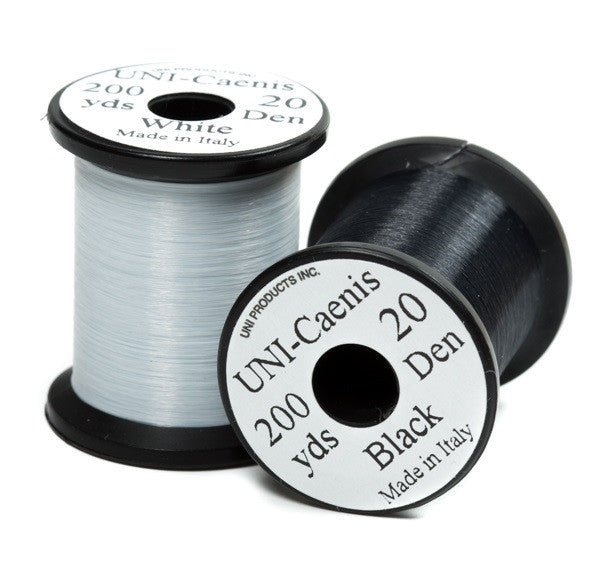Thread is one of the most fundamental of fly tying materials, and today there are dozens of fly tying threads available in a wide variety of materials, sizes and strengths. This guide and our handy Fly Tying Thread Comparison Chart will help you choose the thread that's right for you!

Fly Tying Thread Material
The most common fly tying thread materials today are nylon, polyester and GSP (gel-spun polyethylene). Nylon was developed in the 1930’s as a man-made substitute for silk. Made via a continuous extrusion process, nylon is strong, can stretch a bit and takes dyes well making for bright and vibrant colors. Similar to nylon, man-made polyester is made as either a continuous extrusion fiber or as short fiber filaments. Unlike nylon, polyester doesn't stretch and it will break without warning under stress, though it is quite strong. Polyester colors tend to be slightly less bright than nylon. Gel-spun polyethylene (GSP) is made of continuous extrusion fibers and is very strong. GSP's texture is extremely slippery yet flexible. Less popular but still in use are natural threads made of cotton, wool and silk as well as man-made Kevlar and rayon.
Fly Tying Thread Brands
Of the top fly tying thread manufacturers, UNI uses both nylon and polyester, Danville uses nylon, VEEVUS has polyester and GSP threads and Wapsi both nylon and GSP products. For fly tying traditionalists, there is also fly tying silk from Au Ver á Soie.
Thread Size Measurement
Thread is usually sized either by denier or aught (0) size. Denier is a textile industry convention. A particular thread’s denier equals the gram weight of 9,000 meters of thread. Therefore the lighter the thread, the lower the denier and vice versa. Aught (0) size is an older, less accurate definition with the more ‘0’s” indicating finer thread. Therefore, an 8/0 thread which would be measured as 8 zero’s is much finer than a 3/0 thread which would have 3 zero’s as a measurement.
Breaking Strength
Another dimension of thread is breaking strength which is very important to fly tyers as we want to wrap thread tightly around our hook and not risk breaking it. Recent advances in thread production have led to some light weight threads with comparatively very high breaking strengths. GSP threads definitely have the highest breaking strengths for their weight and the VEEVUS brand from Denmark has developed threads with very high breaking strengths for their size.
We stock dozens of fly tying threads and feature many different brands, including the following:
Within each brand we carry all of the most popular materials and sizes. To give you a complete overview of the specifications (size, weight, breaking strength) of the thread we stock, we’ve put together a handy chart for Comparing Popular Fly Tying Thread. Keep a copy by your fly tying bench!


16 comments
van
Dear Sir
I Need a supplier or Individuals who can Participate to ongoing contract to supply any of this items :
1.T-shirt
Thanks2.Towels,
3.Hat caps
4.Glove
5.Disposable Isolation Gowns
6.Medical Face Masks
7.Medical Infrared Thermometer
8.ppe
9.thread
10.Drilling Pipes
11.Hospital equipment
12 T-SHIRT PRINTING
13 COTTON YARN
To my Organization for Bidding Project.
mr van azad
John Harris
While the Danville and Wapsi (Ultra) threads are both stranded unbonded nylon, I find the Wapsi to be shinier and better looking on the fly. However, the strands of the Wapsi appear to be smaller or weaker than the Danville as I almost always wind up with a floating strand when using it. This rarely happens with the Danville so it is my preference. I often put on and take off wraps and have found the Veevus thread to have a stronger memory, which is annoying.
Robert O’Brien
Great chart! I’m a novice at fly tying only been doing it for a couple years. This chart will definitely help me with selecting the best thread to use.
Bob Betts
Pier, I can help with your question, based on my experience with the various threads. Any thread that is multifilament and unbonded will split well for dubbing. Wapsi Ultra threads, Ultra 70 and Ultra 140 come to mind. Veevus splits well for its polyester and GSP threads. Danville splits well. Uni is partially bonded and doesn’t split well.
Ed
What about UNI 8/0 & UTC70?
Dan Daufel
Great post! Thanks for providing the chart. It is very useful, and I printed it out.
Lee Weil
Very useful resource. Especially with the newer products and sometimes unavailability of the old favorites.
David Jobes
Thought I knew about threads but this was really interesting. Need more information of this type.
Ken Willett
Thread guide information was great reading for me thanks.
Bob M.
That chart was in an order I received.It was so informative that I went to Staples and made a pile of copies that have been passed out at club meetings,veteran tying night classes,and other tying classes.Also the bead sizing chart.
Great advertisement for J. Stockard too.
alejandro
Excelente tabla!!! Muchas gracias, ya la estoy imprimiendo, plastificando y colgando en la estación de atado. Cordialmente, Alejandro.
Pier
Very helpful!
Would be useful to know which thread splits the easiest for dubbing loops application. Can you make some recommendations please.
Thx
Pier
Richard Bailey
Great chart, very useful comparison for many sizes of flies. One question…… where’s the details for Uni 8/0? It’s a thread that I use quite a bit for Stillwater chironomid applications. My sense is that it’s close to 70 denier Flymaster in diameter
Dale Yamamoto
Thanks for producing this chart. It’s great and just printed it on some heavier card stock to keep on my tying desk.
Santiago Ratti Denevi
This is tremendous, game changer.
Bob Littlejohn
Great updated thread chart. I have a multi-page folder with more than just the basics, but this is what I need at my fly tying desk. And on my birthday too!! Thanks